| CAT# | Product Name | M.W | Molecular Formula | Inquiry |
|---|---|---|---|---|
| A14001 | Angiogenin (108-122) | 1781.01 | C78H125N25O23 | |
| A14002 | Angiogenin (108-123) | 1878.1 | C83H132N26O24 | |
| A14003 | rec Angiogenin (human) |
It wasn't until 1985 that Vallee and colleagues at Harvard formally described angiogenin (ANG). It gives the first direct evidence for Folkman's theory that tumor growth is angiogenesis dependent, and it is the first protein found to stimulate the growth of blood vessels that is obtained from a human tumor. Due to its ability to induce the development of new blood vessels in rabbit cornea, meniscus, and chicken chorioallantoic membrane at femtomolar concentrations, ANG is among the most potent angiogenic agents. Some angiogenic factors, such as VEFG, basic fibroblast growth factor, acidic fibroblast growth factor, and epidermal growth factor, have been shown to promote angiogenesis, and ANG has been suggested as a factor that allows this to happen. In the last 30 years, we have a much better understanding of the processes by which ANG induces tumor angiogenesis.
Plasma, amniotic fluid, tumor microenvironment, and cerebrospinal fluid (CSF) all contain ANG, a secreted growth factor, in normal human bodies. It appears that ANG's physiological and pathological roles extend beyond neovascularization, given its ubiquitous expression pattern. Cancer development, neuroprotection, inflammation, innate immunity, cell division, and tissue repair are just a few of the numerous pathologic processes demonstrated to involve ANG. Neurodegenerative disorders like Parkinson's disease (PD) and amyotrophic lateral sclerosis (ALS) are associated with mutations that cause the ANG gene in humans to lose its function. The majority of ALS-associated mutations interfere with ANG's ribonucleolytic activity or subcellular distribution rather than its secondary structure or stability. This has sparked a desire to learn more about ANG's functions in the brain and spinal cord, particularly in neurodegenerative diseases, in the hopes of discovering new ways to diagnose these disorders and potential treatments for them.
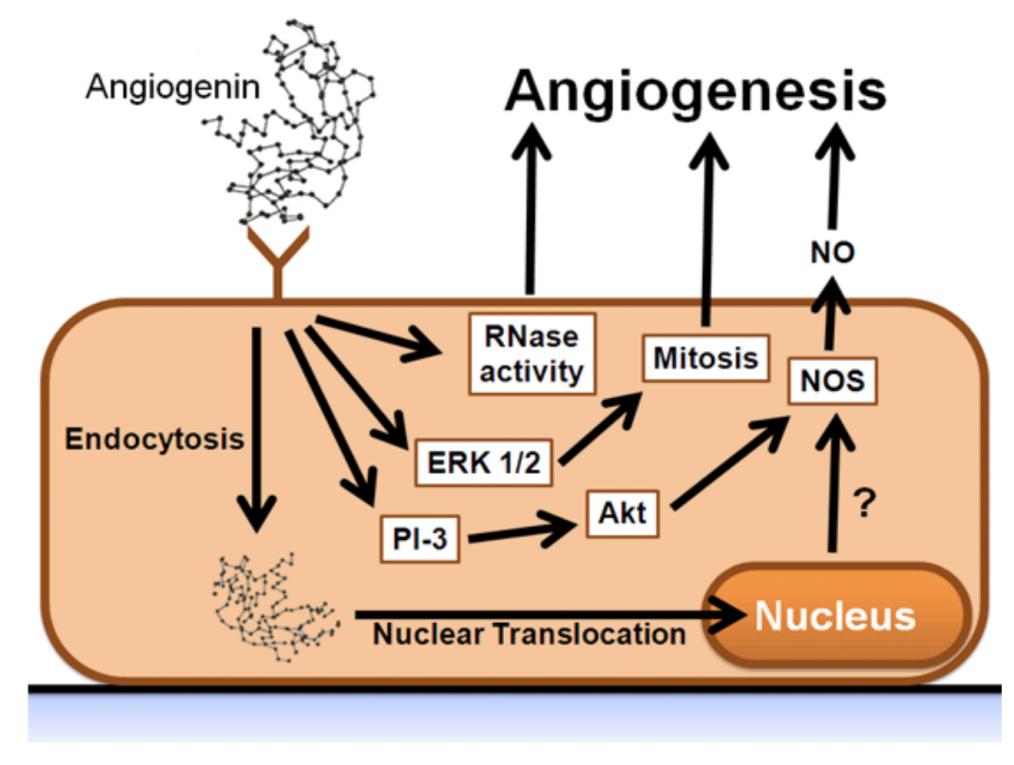
The pathways of angiogenin. (Trouillon R., et al., 2011)
Invertebrates lack the Angiogenin (ANG) gene that is present in virtually all vertebrates, including birds, reptiles, fish, and mammals. Six mammalian species—the gibbon, the naked mole rat, the guinea pig, the dog, the giant panda, and the African elephant—were found to lack ANG according to analyses of whole or almost full genomes. The ANG family apparently develops and duplicates from ancestral ANG-like genes in fish, according to structural feature and evolutionary investigations. Paralogous ANG genes have different roles because positive selection has worked on the ANG family. There are six ANG genes in the mouse (Ang1, Ang2, Ang4, Ang5, and Ang6) as well as three ANG pseudogenes (Ang-ps1-3), making it the animal with the biggest recognized ANG family. Only Ang1 has a structural similarity with the human ANG gene and demonstrates angiogenic activity.
Genes encoding ANG are often found in the center of the RNase A superfamily cluster and share a single exon with all other known ribonucleases (RNases). Specifically, the ANG loci in humans and mice show a different pattern of gene organization, with promoters shared and 5′-untranslated regions (5′-UTR) directing two separate exons expressing ANG and Ribonuclease 4 (RNASE4, the fourth member of the RNase A class, respectively). In this unusual gene arrangement, either a universal promoter or a liver-specific promoter regulates the transcription of ANG and RNASE4. The amounts of ANG and RNASE4 expression should be comparable since the promoter is often important in regulating mRNA transcription and the 5′-UTR impacts translation efficiency. It is worth noting that ANG and RNASE4 have very comparable or equal tissue distribution and cellular localization or secretion in humans, mice, and cattle. In our lab, we found that RNA polymerase III elements and an intragenic chromatin loop reliant on CCCTC binding factor (CTCF) govern the transcription of these two genes. To control crucial biological processes, this unusual gene arrangement of ANG and RNASE4 was postulated to guarantee the coexpression of these two proteins.
The human ANG gene consists of a single exon bordered by short UTRs and encodes a 14 kDa polypeptide. The protein is generated with a 24-amino acid signal peptide, which is cleaved to yield a mature form with 123 amino acids. Sequence research indicated its homology to the Ribonuclease A (RNase A) superfamily, leading to its classification as RNase 5. ANG possesses three primary distinguishing characteristics in comparison to the bovine RNase A family archetype: (1) The distinctive ribonuclease activity towards poly-, di-, and cyclic nucleotides is 104-106 times lower, and its enzymatic specificity differs; (2) the segment between residues 58–70 seems to form a 'cell-binding site,' separate from the active site, likely engaged mainly in protein-protein interactions; and (3) the segment 31-35 serves as a nucleolar localization signal. All these traits are critical to angiogenic action, as demonstrated by directed mutagenesis experiments.
Other mammalian species for which whole-genome sequences are available also show promoter sharing and conservation of the 5′-UTR region between ANG and RNASE4. The fact that this genomic organization has persisted throughout evolution is likely due to a selection pressure to keep the two genes regulated together, which implies that they serve a functional purpose. While ANG isn't very effective at ribonucleolytic activity, RNASE4 is an endonuclease that's both well conserved and selective for uridine. Nevertheless, RNASE4's biological functions remain mostly unknown. New research shows that RNASE4, like ANG, can prevent neuron degeneration by enhancing angiogenesis, neurogenesis, and neuronal survival in stressful environments. We found that RNASE4 had tumorigenic activity in our unpublished data. Based on these findings, it seems likely that the two genes have a common role. The biological roles and action mechanisms of RNASE4, either alone or in combination with ANG, in physiological and pathological processes would be fascinating to experimentally ascertain.

Numbers of ANG genes and pseudogenes. (Sheng J., et al., 2016)
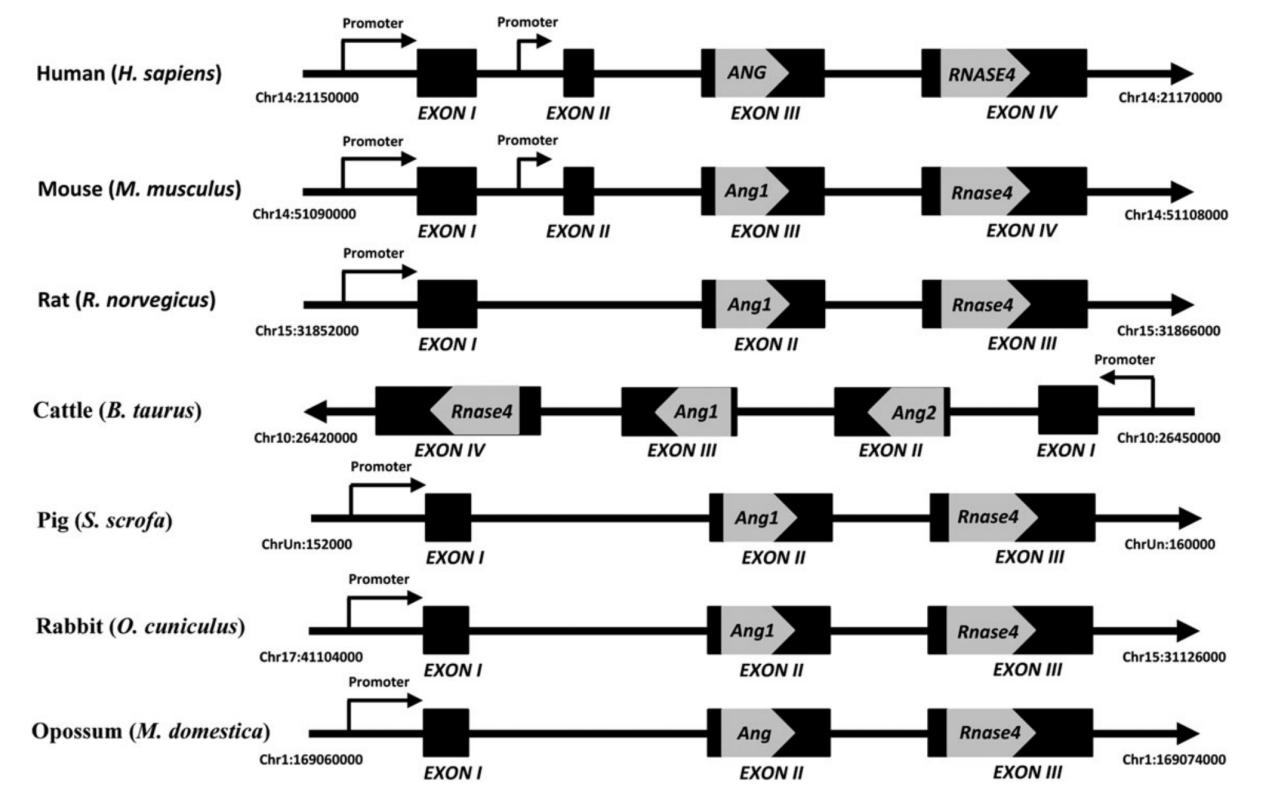
Gene structure of angiogenin (ANG). (Sheng J., et al., 2016)
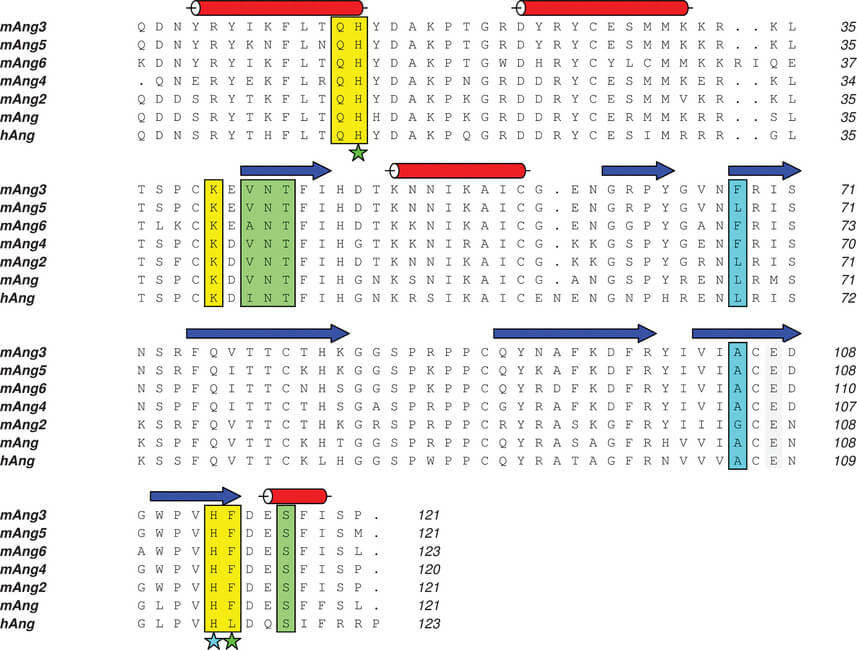
Sequence alignment of the human and murine angiogenins. (Iyer S., et al., 2013)
Although its specificity and activity level varied significantly, ANG is a homolog of bovine pancreatic RNase A (EC 3.1.27.5). The overall catalytic residues and 33% sequence identity and 65% homology of this 14-kDa basic single-chain protein are identical to those of bovine pancreatic RNase A. Phosphodiester bond breakage takes place at the catalytic center (P1), where it contains all three primary catalytic residues (His-13, Lys-40, and His-114). Furthermore, ANG contains the pyrimidine base-binding center (B1) and the purine base-binding center (B2). In contrast to the structure of RNase A, the side chain of Gln-117 in ANG obstructs the B1 center by forming two hydrogen bonds with Thr-44. Gln-117 is kept in its obstructive position by intramolecular hydrophobic contacts formed by Ile1-19 and Phe-120. One rationale for the lower ribonucleolytic activity of ANG is its blockage of the B1 center. Furthermore, ANG is missing its fourth disulfide bond, leaving a loop area from Lys-60 to Lys-68 that can interact with an unidentified receptor on the surface of cells. The NLS for this protein is 30Met-Arg-Arg-Arg-Gly35. You can find it elsewhere. In addition to conferring several biological activities, ANG's unusual ribonucleolytic action is explained by its peculiar structures.
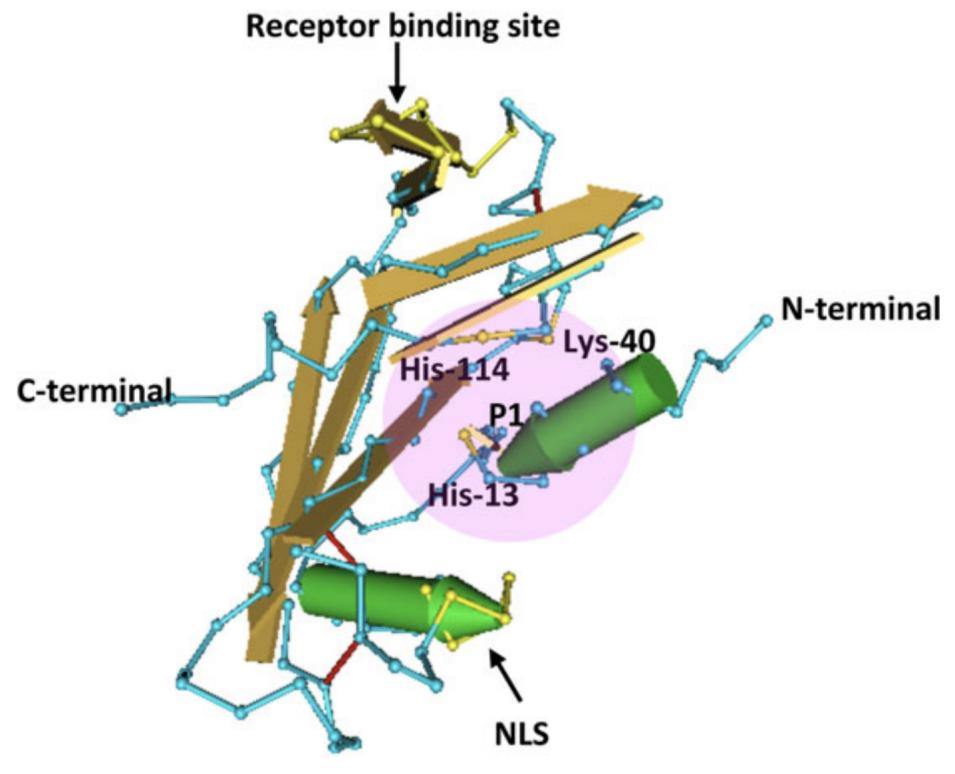
Schematic representation of the crystal structure of human Angiogenin at a resolution of 1.8 Å. (Sheng J., et al., 2016)
From the cell surface to the nucleus, secreted ANG accumulates in the nucleoli by receptor-mediated endocytosis. Multiple investigations have shown that cellular ANG plays a role in nucleic acid metabolism. A recent discovery has shown that ANG in the nucleus can enhance 47S pre-rRNA transcription by interacting with the ABE and UCE regions on the promoter of ribosomal DNA (rDNA). This leads to an increase in the number of rDNAs actively transcribing and, through epigenetic activation, the formation of the initiation complex through modifications to histones and promoter methylation. Then, under growth conditions, ANG may improve rRNA processing by cleaving the 47S pre-rRNA at its first cleavage site (A0) as an endonuclease. Furthermore, ANG has the ability to break down 28S and 18S rRNAs in vitro into their primary components, which range in length from 100 to 500 nucleotides. Thus, ANG may play a role in the processing and degradation of rRNA in addition to regulating its transcription. The last two roles require additional in vivo investigations.
Conversely, mRNA transcription has been linked to multiple lines of evidence suggesting that excess ANG in the nucleus is connected. ANG suppresses the production of estrogen receptor-related receptor gamma (ERR}) by binding to its first exon region. We used a chromatin immunoprecipitation-chip assay to find 699 genes that could be ANG regulators, allowing us to search for ANG-regulated mRNAs across the whole genome. Data from the Kyoto Encyclopedia of Genes and Genomes (KEGG) research demonstrated that these genes were much more prevalent in cancer, Wnt, and TGF-β pathways. The fact that ANG can modify histones by attaching to them directly suggests that it controls messenger RNA transcription via activating chromatin remodeling. There is no proof that ANG is an enzyme that modifies DNA, thus it could be that it acts as an adapter or structural protein that brings other enzymes that do DNA modifications to the DNA. So, there's still a lot of work to be done in order to figure out how ANG works in gene transcription.
The cytoplasmic tRNA metabolism is another crucial process in which ANG participates. Surprisingly, quantitative enzymatic testing of ANG was the initial application of tRNA. Recent research has shown that when subjected to stress, such as oxidative, hypoxia, or starvation stress, ANG cleaves either the conserved single-stranded 3′-CCA termini of transfer RNA (tRNA) or the tRNA anticodon loop, resulting in the formation of tiRNA, or tRNA-derived, stress induced short RNA. In addition, the generation of tiRNA mediated by ANG is tightly controlled. The patterns of tiRNA creation, for instance, are stress-specific or stress-intensity dependent. You can prevent ANG-induced tRNA cleavage by modifying the anticodon loop of the chosen tRNA (ValAAC, GlyGCC, and AspGTC). To manage tiRNA synthesis in response to stress, RNH1 can also control ANG's stress-induced subcellular location. The creation of tiRNAGlu is enhanced during respiratory syncytial virus (RSV) infection. This process is facilitated by ANG and has the ability to target messenger RNA (mRNA) in the cytoplasm, hence enhancing RSV replication. Furthermore, ANG-mediated tiRNA synthesis is significantly functionally involved in cell proliferation, and sex hormones and their receptors can boost this process.
Endothelial cells in a tumor microenvironment can take up extracellular ANG, which binds to actin, and forms a complex known as AngBP. Plasminogen can be converted into plasmin by use of this complex, which is catalyzed by tissue-type plasminogen activator. Modifications to the cell cytoskeleton, including the inhibition of G-actin polymerization and alterations to the physical characteristics of F-actin, are induced by the interaction between ANG and cell-surface actin. The matrix metalloproteinase system and the plasminogen activator/plasmin serine protease system are among the protease cascades that may be activated when ANG interacts with cell-surface actin. According to recent research, ANG mediates indirect interactions between uPAR and the plasminogen receptor, A2, S100-A10 complex, which is essential for plasmin formation and cell migration. These interactions take place at the junction of the lipid raft and nonlipid raft areas of cell membranes. A peptide (ANI-E) was found to be able to suppress ANG-induced angiogenesis and the interaction between ANG and actin by phage-display technology, according to subsequent research. As an added bonus, ANG boosts endothelial cell migration and invasion and increases fibrinolytic activity in GM7373 cells cultured on fibrin gels. ANG, in contrast to RNase A, can facilitate the attachment of many target cells when coated at concentrations of 100 ng/cm2 or higher. This suggests that ANG may facilitate endothelial cell migration and penetration by increasing the breakdown of the basement membrane and extracellular matrix. Furthermore, by interacting with β-actin, α-actinin 4, and nonmuscle myosin heavy chain 9, our research has shown that cytoplasmic ANG enhances stress fiber assembly and focal adhesion creation to accommodate cell migration.
A concentration of 200-400 ng/ml of ANG is found in human plasma. While ANG can stimulate the development of new blood vessels in the chorioallantoic membrane of chicken embryos at concentrations as low as 0.5 ng, it does not have the same effect in adults at these concentrations. To all appearances, this is a paradox. The confluent endothelial cells that make up the blood arteries are not triggered to produce ribosomes by ANG. Confluent cell membranes do not contain the ANG receptor, although sparsely cultivated endothelial cell membranes do. Yet, ANG has a role in the process of wound neovascularization. There is some evidence that ANG may enhance wound healing at the expense of vascular integrity when damaged clots disturb endothelial cell confluence. This is because ANG, when present in high concentrations in blood vessels, may accelerate fast expansion of blood vessels and tissue repair. The cell cycle activity of endothelial cells is also linked to hemodynamic stresses; in mature tissues, cell turnover of endothelial cells is extremely sluggish. Hence, plasma ANG might affect vascular homeostasis by keeping endothelial cells from self-degrading.
The physiological process of pregnancy causes typical tissues to undergo vascular remodeling and angiogenesis. Uncomplicated pregnancies are associated with an elevated blood ANG level, which may indicate that ANG is involved in normal perinatal vascular development. The expression of ANG does occur throughout the early stages of placental development in humans. Paracrine signals released by cytotrophoblasts may promote the proliferation and development of endothelial cells. Additionally, decidual cells originating from the first trimester of the placenta express ANG, as do stromal and epithelial cells within the placenta. During the early and late stages of gestation, there is an upregulation of ANG expression in the endometrium. Immunosuppression is well-documented in decidual environments. Immunomodulator ANG (described further below) may play a role in maternal tolerance to the semiallogeneic fetus.
As previously stated, ANG is associated with many forms of inflammatory activation and has a role in the innate immune system. Tears contain ANG, an antimicrobial peptide that aids in the body's natural defenses by protecting the eye's surface from infection. Additionally, ANG is shown to play a role in the innate antimicrobial defense of the intestine and is highly increased in Paneth cells. Aside from its antibacterial properties, ANG also possesses antiviral actions. The X4 HIV strains can have their replication stymied by ANG, one of the two RNases generated by primary T cells. Chronic hepatitis B and C infection is characterized by a rise and abundance of ANG-mediated tiRNAs, which suggests that ANG may have involvement in viral infection. Additionally, ANG could possess anti-inflammatory properties due to the fact that its serum protein concentrations are elevated following the inflammatory response or treatment with tumor necrosis factor alpha and interleukin -1β. One possible way that ANG reduces inflammation is by blocking the nuclear translocation of NF-κB, which is mediated by TBK1. To back up this recommendation, more evidence is needed. Further evidence that ANG may be involved in endogenous inhibitory mechanisms to counteract plasma-derived inflammatory response molecules is its ability to prevent polymorphonuclear leukocyte degranulation.
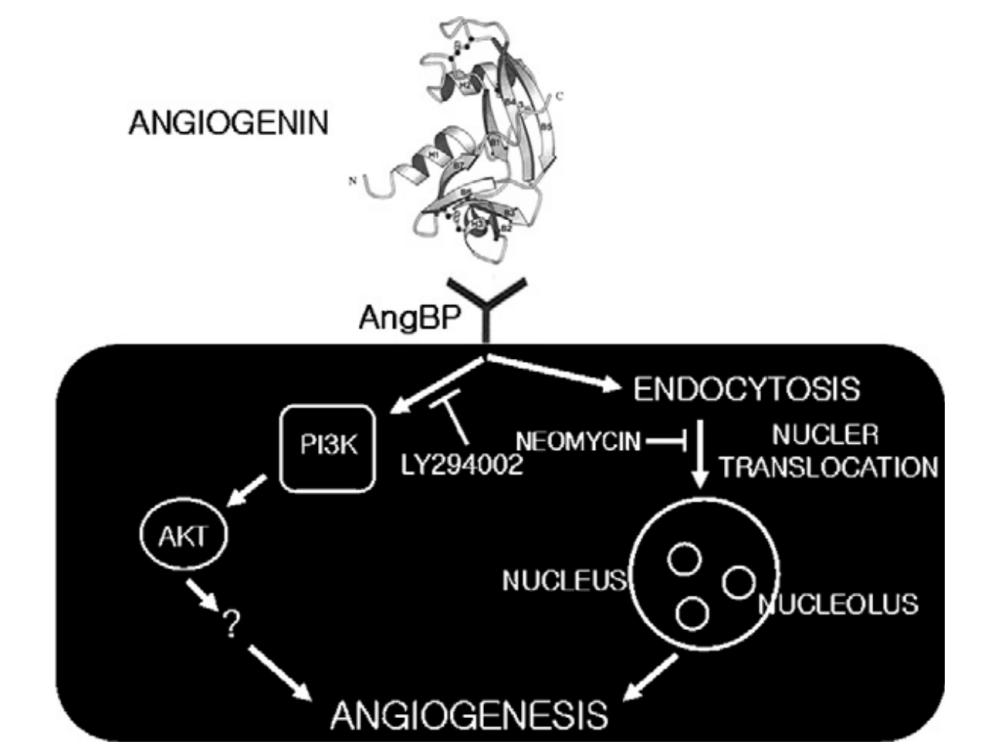
Mechanism of action of angiogenin. (Kim H M., et al., 2007)
Multiple factors, including epigenetic and genetic alterations in tumor cells and specific tumor microenvironmental factors, contribute to the multi-stage process known as tumorigenesis. From what we can tell, ANG has an effect on almost every stage of carcinogenesis, from defending tumor cells from harmful environments to encouraging their proliferation, improving their motility and invasion, and even causing angiogenesis.
In solid tumors, there are often areas with less-than-ideal growth settings; cells in these areas often rewire their gene expression to thrive in these environments. ANG is a protein that reacts to stress. Cell lines from humans with malignant melanoma and cervical cancer secrete far more ANG when exposed to low oxygen levels. Lymphoma cells found in the body's cavities that are infected with tumor viruses, such Kaposi sarcoma-associated herpesvirus, rely on ANG to stay alive. ANG expression in hypoxia-exposed cells can be activated by the presence of hypoxia-inducible factor-1, a transcription factor that controls the expression of genes that respond to low oxygen levels. By blocking p53's serine-15 phosphorylation and the binding of Mdm2, ANG inactivates p53 mechanistically. This leads to p53's ubiquitination. ANG cleaves tRNA, which reprogrammes protein translation and starts the mammalian stress response. This helps cells repair damage and survive. Nevertheless, the exact process by which ANG controls cell survival and death remains mostly unclear.
Secreted by tumor cells into the tumor microenvironment, ANG promotes tumor growth. The growth of tumor cells can be accelerated by ANG. Without regard to cell density, this protein can persistently translocate into tumor cell nuclei, where it promotes cell proliferation. Glioblastoma secretes ANG, a key component of microvesicles (MVs), which promotes endothelial cell tubule development. Extracellular matrix composition modification and induction of hepatic stellate cells are both facilitated by ANG secreted by hepatocellular cancer cells. Microenvironmental ANG is enough to invade fibroblasts associated with prostate cancer, and it can also induce the invasion of normal fibroblasts in the prostate. Endothelial cells may be able to infiltrate and migrate into tumors when ANG promotes breakdown of the basement membrane and extracellular matrix. A distinct kind of immune cell called a mast cell can release ANG to stimulate blood vessel growth in malignancies. In addition, ANG is primarily responsible for the angiogenesis-promoting actions of MVs generated from mesenchymal stem cells in hypoxia or serum deprivation. The fibrosarcoma HT1080 cells can be induced to resemble vasculogenic pathways by ANG as well. Research has shown that angiogenesis and vasculogenic mimicry, both of which enable tumor cell metastasis through blood arteries, may be facilitated by ANG. Since ANG has an immunosuppressive activity, it is possible that this is another way it operates in the tumor microenvironment.
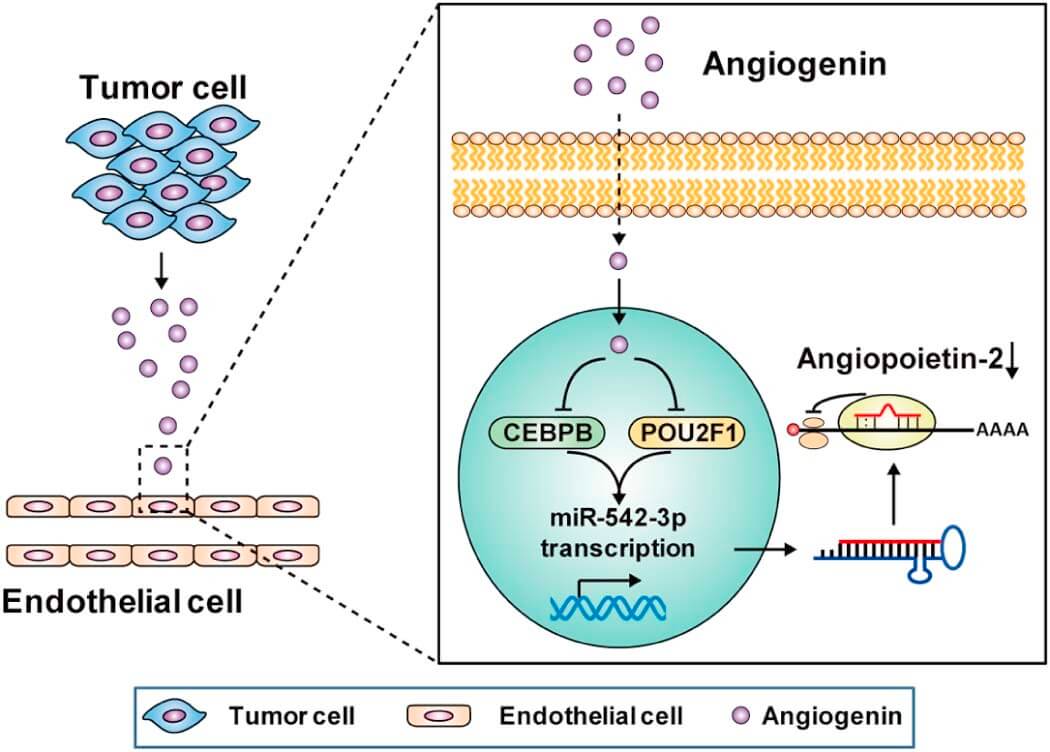
ANG induces angiogenesis in tumor microenvironment. (He T., et al., 2015)
References